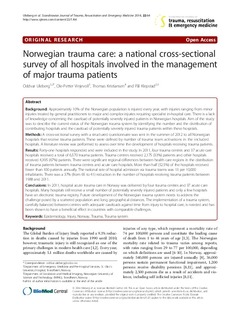| dc.contributor.author | Uleberg, Oddvar | |
| dc.contributor.author | Vinjevoll, Ole-Petter | |
| dc.contributor.author | Kristiansen, Thomas | |
| dc.contributor.author | Klepstad, Pål | |
| dc.date.accessioned | 2015-01-08T08:02:14Z | |
| dc.date.accessioned | 2015-03-11T09:30:18Z | |
| dc.date.available | 2015-01-08T08:02:14Z | |
| dc.date.available | 2015-03-11T09:30:18Z | |
| dc.date.issued | 2014 | |
| dc.identifier.citation | Scandinavian journal of trauma, resuscitation and emergency medicine 2014, 22(64) | nb_NO |
| dc.identifier.issn | 1757-7241 | |
| dc.identifier.uri | http://hdl.handle.net/11250/278886 | |
| dc.description.abstract | Background: Approximately 10% of the Norwegian population is injured every year, with injuries ranging from minor
injuries treated by general practitioners to major and complex injuries requiring specialist in-hospital care. There is a lack
of knowledge concerning the caseload of potentially severely injured patients in Norwegian hospitals. Aim of the study
was to describe the current status of the Norwegian trauma system by identifying the number and the distribution of
contributing hospitals and the caseload of potentially severely injured trauma patients within these hospitals.
Methods: A cross-sectional survey with a structured questionnaire was sent in the summer of 2012 to all Norwegian
hospitals that receive trauma patients. These were defined by number of trauma team activations in the included
hospitals. A literature review was performed to assess over time the development of hospitals receiving trauma patients.
Results: Forty-one hospitals responded and were included in the study. In 2011, four trauma centres and 37 acute care
hospitals received a total of 6,570 trauma patients. Trauma centres received 2,175 (33%) patients and other hospitals
received 4,395 (67%) patients. There were significant regional differences between health care regions in the distribution
of trauma patients between trauma centres and acute care hospitals. More than half (52.5%) of the hospitals received
fewer than 100 patients annually. The national rate of hospital admission via trauma teams was 13 per 10,000
inhabitants. There was a 37% (from 65 to 41) reduction in the number of hospitals receiving trauma patients between
1988 and 2011.
Conclusions: In 2011, hospital acute trauma care in Norway was delivered by four trauma centres and 37 acute care
hospitals. Many hospitals still receive a small number of potentially severely injured patients and only a few hospitals
have an electronic trauma registry. Future development of the Norwegian trauma system needs to address the
challenge posed by a scattered population and long geographical distances. The implementation of a trauma system,
carefully balanced between centres with adequate caseloads against time from injury to hospital care, is needed and has
been shown to have a beneficial effect in countries with comparable challenges.
Keywords: Epidemiology, Injury, Norway, Trauma, Trauma system | nb_NO |
| dc.language.iso | eng | nb_NO |
| dc.publisher | BioMed Central | nb_NO |
| dc.subject | Epidemiology | nb_NO |
| dc.subject | Injury | nb_NO |
| dc.subject | Norway | nb_NO |
| dc.subject | Trauma | nb_NO |
| dc.subject | Trauma system | nb_NO |
| dc.title | Norwegian trauma care: a national cross-sectionalsurvey of all hospitals involved in the managementof major trauma patients | nb_NO |
| dc.type | Journal article | nb_NO |
| dc.type | Peer reviewed | en_GB |
| dc.date.updated | 2015-01-08T08:02:14Z | |
| dc.source.pagenumber | -7 | nb_NO |
| dc.source.volume | 22 | nb_NO |
| dc.source.journal | Scandinavian Journal of Trauma, Resuscitation and Emergency Medicine | nb_NO |
| dc.source.issue | 64 | nb_NO |
| dc.identifier.doi | 10.1186/s13049-014-0064-0 | |
| dc.identifier.cristin | 1178634 | |
| dc.description.localcode | Open access tidsskrift. Creative Commons Attribution License. http://www.sjtrem.com/ ; http://www.sjtrem.com/content/pdf/s13049-014-0064-0.pdf | nb_NO |
